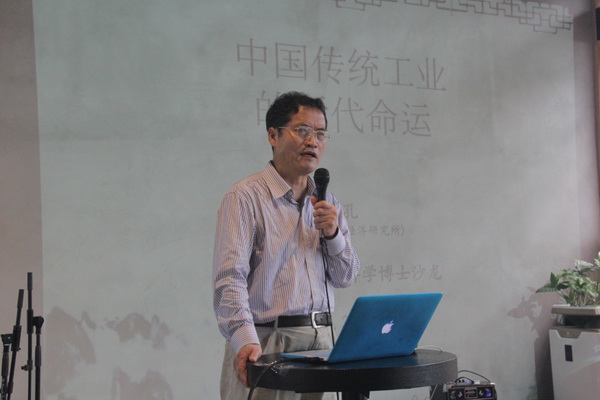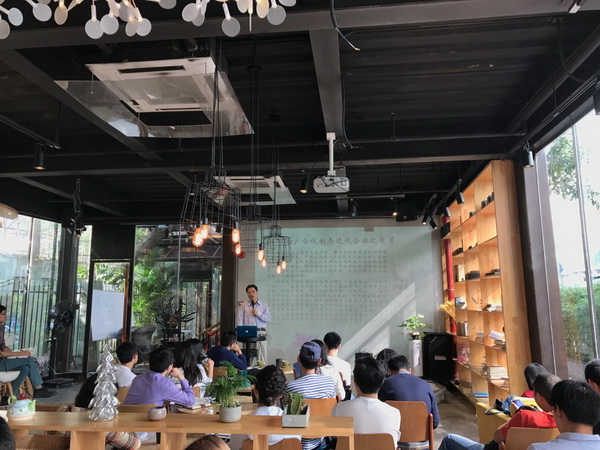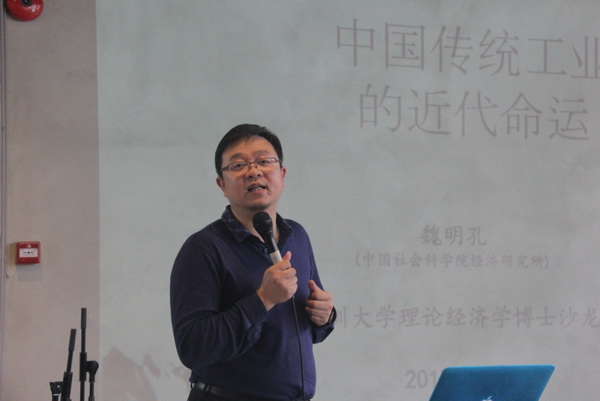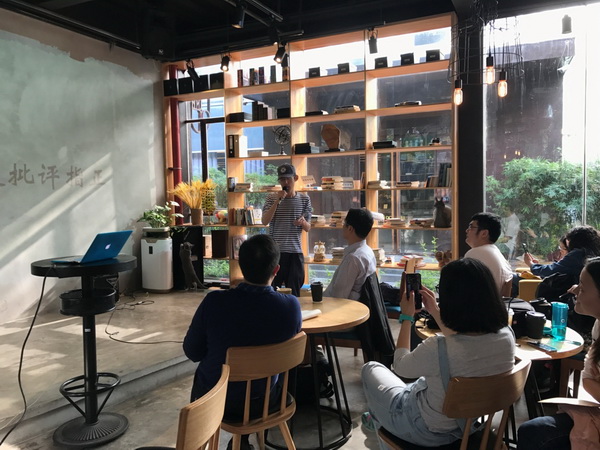March 20, 2017 witnessed the 1st Academic Salon for Ph.D. students in Theoretical Economics in 2017 (the 29th in history) hosted by the China Center for Special Economic Zone Research (CCSEZR) at Maoshuli Café near the West Gate of Shenzhen University (SZU). Prof. Wei Mingkong, president of the Economic History Society of China, a researcher at the Institute of Economics of the Chinese Academy of Social Sciences (CASS), and president and editor-in-chief of the journal Researches in Chinese Economic History delivered an impressive speech titled “Modern Fate of Traditional Chinese Industries”. The academic salon was presided over by Prof. Zhong Ruoyu, an assistant to CCSEZR director, and attended by a number of teachers, Ph.D. students, and graduate students at CCSEZR. During the pre-salon session, Prof. Zhong Ruoyu, on behalf of CCSEZR, warmly welcomed Prof. Wei for delivering an academic lecture at SZU and gave a brief account of Prof. Wei’s academic experience and achievements.
Prof. Wei started off the lecture by illustrating the development track of traditional Chinese industries. Before the industrial revolution took place in the UK, China was one of the major civilization output countries in the world, which has a great deal to do with the leading status of traditional Chinese industries at the time. After basic production patterns are completely reshaped by the industrial revolution, although Chinese handicraft industries have not come to a halt, yet they can no longer sustain the superiority enjoyed by Chinese civilization in the world. Prof. Wei further explained at length the seven traits exhibited in traditional Chinese industries: a. dynamic domestic sideline productions; b. advanced governmental handicraft workshops; c. pervasive "front shop, back factory" model integrating production and sales functions; d. development of partnership and its influence on modern enterprises; e. private handcraft producers’ preference on land investments; f. a dramatic shift in industrial manufacturers’ status; g. father-son or brother-brother pass-on of workmanship and techniques. He then mentioned that China had long invented highly advanced handicraft techniques in the history and led the world in a considerably long period of time. China’s four great inventions have unquestionably contributed to the advancement of human society and to some extent, brought real transformations to human history. The problem is that why Chinese handicraft expertise failed to give birth to capitalist industrial production on its own soil and advance Chinese society to the same level as the capitalist societies in the Europe during modern times despite the fact that it had been considered among the most advanced expertise in the world for a long period of time? Prof. Wei shed light on the answer in the following three aspects: first, the transformation of traditional Chinese handicraft industry is a rather complex economic process. A sound transformation environment, satisfaction of conditions for transformation, appropriate transformation policies, and comprehensive supporting measures are all indispensable to a successful transformation; second, traditional Chinese society had every possibility to embark on the path to modernization in terms of market, raw materials, labor, capital, and in particular, technologies. However, it eventually far lagged behind Europe as a result of a lack of both demand and supply needed for the spontaneous transformation to modernized industry. Lack of driving demand is the result of following factors: on the one hand, agricultural revolution is not completed, which means agricultural self-sufficiency limits the amount of surplus and demands in the market; on the other hand, the government adopted a self-fettered diplomatic strategy, isolating China from international markets. Meanwhile, the reasons behind the lack of supply include, firstly, the preponderance of handcraft workshops and individual small-scale producers and a lack of prevailing large-scale production entities and the ability to invest in techniques or technical innovation and experiments, and secondly, the failure in converting commercial capital into industrial capital. The lucrative circulation section left little room for production profits, fueling the traditional system of stressing agriculture and restraining commerce and taking its toll on the investment in production. To conclude, given the absolutism in traditional Chinese society and the formation of state system, the failure in the transformation from traditional Chinese industries to modernized industries is unavoidable. However, from a historical perspective, it is abnormal for the handicraft industry that has maintained its leadership in traditional society for a long period of time not being modernized. The ideas above are the basic conclusions we have drawn on traditional Chinese industries after conducting an investigation.
After the speech, Prof. Wei actively discussed with teachers and students at the CCSEZR on the lack of traditional Chinese workmanship spirit in modern society, a big divergence between the East and the west in modern society, and the contingency in the modern transformation of the west, among other topics. Finally, the salon was concluded with Prof. Zhong Ruoyu’s excellent commentary on the lecture.

Prof. Wei Mingkong delivers an impressive speech
Academic salon for Ph.D. students
Prof. Zhong Ruoyu presides over the salon
Discussion session of the salon



